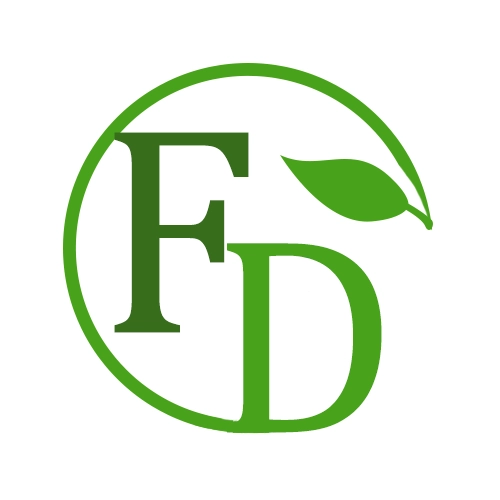Presented by Anastasia Fiadosenka
About Anastasia Fiadosenka
Jacques Lochard introduced Anastasia at Dialogue Seminar in Date City on July 9 2017
Anastasia was born in the village of Kaporenka in the Bragin district, Belarus, located only 22 kilometres away from the Chernobyl NPP. (The Bragin district was one of the most affected areas by the Chernobyl accident) She went to the school a few kilomerers from her village, and she got her degree from Vitebsk Veterinary Institute in 1972. At the time of the accident, she was working as a cattle breeder at a collective farm.
She evacuated her village with her family (mother and sister) on May 4, 1986 – it was ten days after the accident. On May 4 and 5, she controlled the livestock evacuation from the 30 km evacuation zone. She belongs to the group of people known as “liquidators” of the Chernobyl accident.
After the accident, Anastasia became a dosimetrist at the collective farm of the village of Krasnoe, where she lives now. In 1994, she started working with Professor Nesterenko to measure foodstuffs’ contamination from private production as a dosimetrist. She measurs foods and livestock, talks to the people, and keeps the records of all measurements she makes every day. Anastasia’s notebooks are the memories of 2 decades about the radiological situation in Komarin.
Between 2004 and 2008, French experts developed the CORE programme with the local population to improve young children’s protection against internal contamination. During these four years, she played a key role in the success of the project.
After 2008 she continued to work at the local population’s service and the transmission of her experience to the next generation and experts from Western Europe and, more recently, to the affected people of Fukushima.
“My everyday work at the Kamarin Radiological Control Centre.”
Anastasia Fiadosenka
Dialogue Seminar in Fukushima City on July 6
https://docs.google.com/file/d/0BxqSmDmQ78xCSTlpOG91Nmlqanc/edit
My name is Anastasia Fiadosenka. I was born about 20 km away from the Chernobyl NPP, and I grew up in that area and continue to live there. I had to move from that village after the Chernobyl accident, and I now live in a neighbouring village about 10 km away from my home village. And I work at a low dose radiological control centre in the village. I basically do agricultural work connected with cattle breeding and obtaining meat, milking and things like that for the state enterprise.
On April 26, 1986, when the accident happened, people had no idea how dangerous the event was. The information about the accident was classified as top secret. The neighbouring regions’ inhabitants knew absolutely nothing about it and continued the usual lifestyle for about a week. I will demonstrate to you what happened to me three days after the accident. Together with a team of men, I had to go to the field about 15 km away from the rector and started building fences for houses. I worked all day there in that open area.
On April 29, the local authority decided they may need to relocate pregnant women and children under fifteen years old. Two more days later, the school children were all relocated. On May 3, which was eight days after the accident, the local authority called me and said that we need to organize the evacuation. The phone call came at 2 a.m. I want you to imagine the situation – it was Saturday morning at 2 o’clock. I went out to do the relocation job, and I returned home only on Monday evening.
Sometimes the relocation was weird because they determined the 30km radius zone. Sometimes the zone actually cut one village into two, and we had to relocate one half of the village to the other half of the village. We told all people that we would relocate only for three days. So, they were allowed to take the only necessities, such as documents, money, and personal belongings. We had to take care of the cattle, and we left all chicken behind.
I heard in some presentations of the Dialogue, someone mentioned that radiation was the enemy. Then you cannot sense it with your usual senses, and so people were not ready psychologically. A lot of them resisted relocation and insisted on staying.
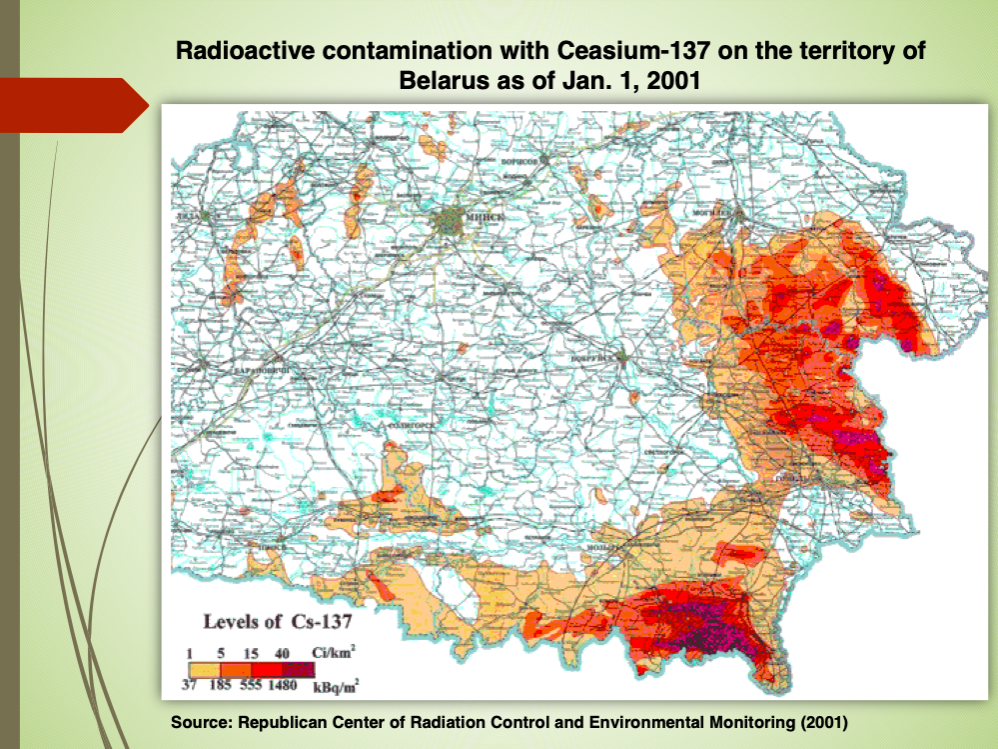
I will show the map of radiological contamination. You can see here how the territory of Belarus was contaminated, especially those southern regions. Chernobyl is down here, and Kamarin is here.
Even though the relocation was meant to be for only three days, it lasted until October. We had to accommodate people in other villages, but there was no special housing for them. They had to live with other people from other villages. Only in October, temporary accommodation was provided for them. This is where they continued their life, and most of them never went back to their village.
The state finally became aware of the problem, and they provided the necessary equipment for us. Although it was quite simplistic at that time, we began to monitor the gamma background radiation.
I have been working already for 20 years in the radiological laboratory as a veterinary doctor and dosimetrist. My task is to examine the content or the contamination of the products – all kind of products – with cesium 137. The agricultural production, forage for the animal water, drinking water, beverages everything that people consume. I make a conclusion about whether this product can be consumed or not, and whether it should be disposed or not. The contamination levels were going down.
And in 1999, we established a threshold of 1 mSv for every person per year. The key points are, for example, 100 Bq for milk, 500 for beef and 180 for pork. The criteria for children were set lower.

If you look at pictures after the accident, you can see how the radiation measurement managed the children with the usual dosimeters. On this slide, you can see the plaque installed in the place where the village used to be. It says that the population of this village was 81 people, and there were 44 households in this village in 1987.
We began decontamination even in the village where contamination was severe. We began to wash the roofs of houses, remove the upper layer of soil in yards. However, we did not take off the upper layer of the soil in farmlands because the fuels are too expensive compared to Japan, and we just used to come to different mineral fertilizers to reduce the level of cesium. We discovered by way of experimenting that lands accumulate carbon potassium. If there is enough potassium accumulated in the soil, it will not absorb cesium. Immediately after the accident, the milk was contaminated heavily. Animal meat was also heavily contaminated. Before killing the animals, we had to do the measurement to make sure that it was not possible to use the meat.
All of this work continued on the state level until 2004. In 2004, the French people, the French representatives initiated a problem called the CORE. The program’s point was to inform people about radiological safety and ways to reduce contamination and move from the general level to the individual level. Local centers of radiological control were established. This was the first time when we began to assess and measure the internal accumulation of radiation. The local scientists were equipped with measuring devices and computers.

You can see in this picture the way the usual equipment used.
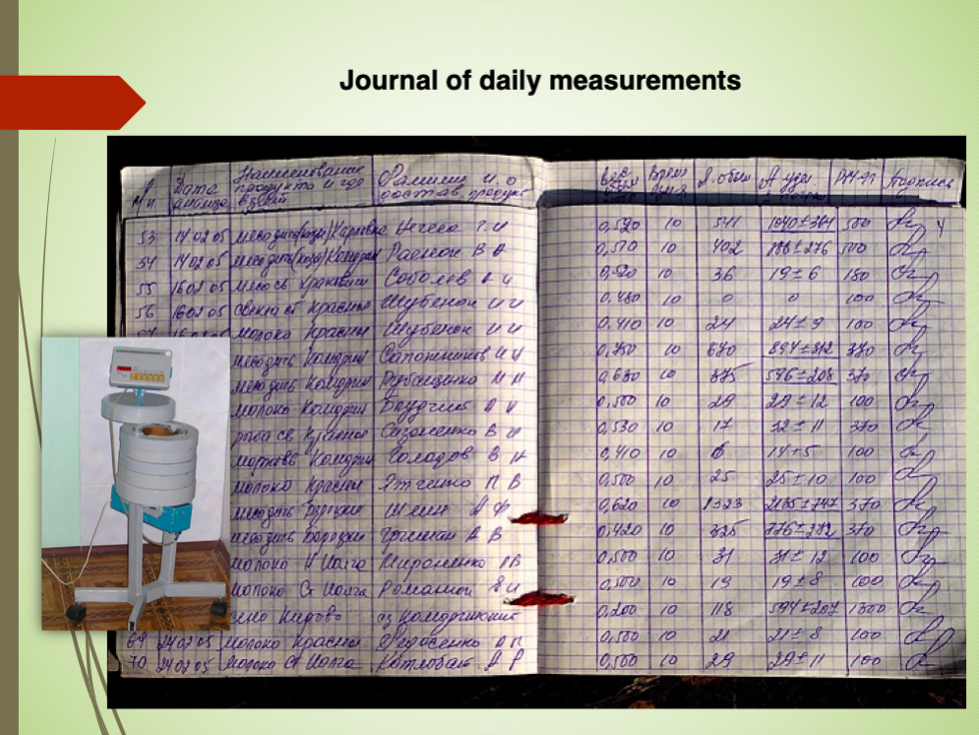
This is one of the registers that we photographed. You can also see all data. It was when we began radiation protection at the individual level. We began to measure the amount of radiation in children 2 times a year. We also did the individual measurement of the so-called whole-body counters. I did the measurement. If we see an elevated level above 20 Bq for children or 70 Bq for grown-ups, I go to those families and analyze the foodstuff samples they consume. I analyze samples and make a conclusion about the source of contamination. Then I return to the family to explain the analysis result to them and tell them what they should not to eat.
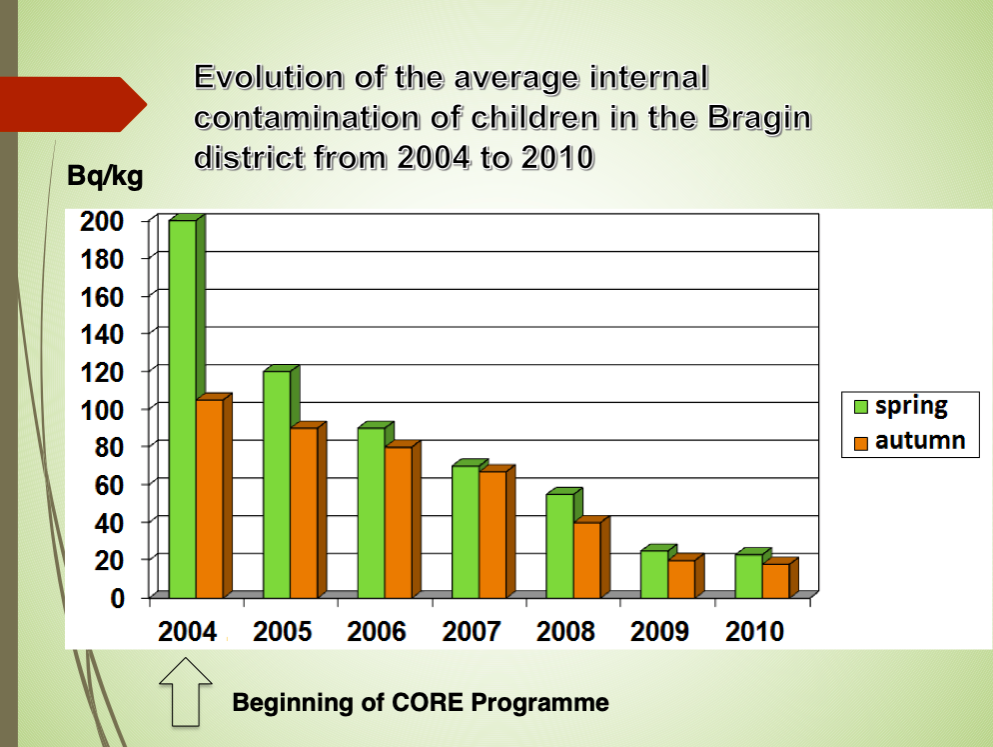
In this diagram, you can see the evolution of children’s average internal contamination in the Bragin district beginning in 2004. The results of the first measurement were shocking. In some of the children, there were 700 Bq per kilogram. One schoolboy had more than in 2000 Bq. The most dramatic change took place in 2004. You can see the difference in spring. It was 200 on average in spring, and then, it was already 100 average in autumn. The present-day results are stunningly different because we rarely see anything higher than 27. All these measurements were done free of charge. People have become slowly aware that if they have doubts about certain foodstuff, they can immediately go to the local radiological center and test the products. I explained many details to them and told them which products were dangerous. For instance, I say to them that wild ones are dangerous. If you catch a wild boar, it doesn’t mean you can eat it. The contamination can reach 10,000 Bq per kilogram.
Alongside the CORE program, there were other programs connected with the education of school children. Different study groups were created for children to learn radiological safety. We organized meetings with parents and classes for volunteers and talks of people who suffered from the accident. A separate organization was created, and it was called Blade of Life. This lady is the head of the organization. She is responsible for distributing literature and recommendations on safe-living pregnant women and young children at village pubs, libraries, medical institutions, educational institutions.
From my personal experience of living 27 years in a contaminated area, I can say that it’s possible to safely live there with simple guidelines and by following safety rules. I compared the gamma radiation diagrams of 27 years ago and today, and it is twice as low now. Radiological safety and the task of organizing radiological safety is a system of measures. It is not just one radiological control centre. There is an interaction of many organizations, such as the ones you can see in the diagram. Sanitary hygienic laboratory, local information centre, families, forestry, central regional hospitals, village councils, etc.
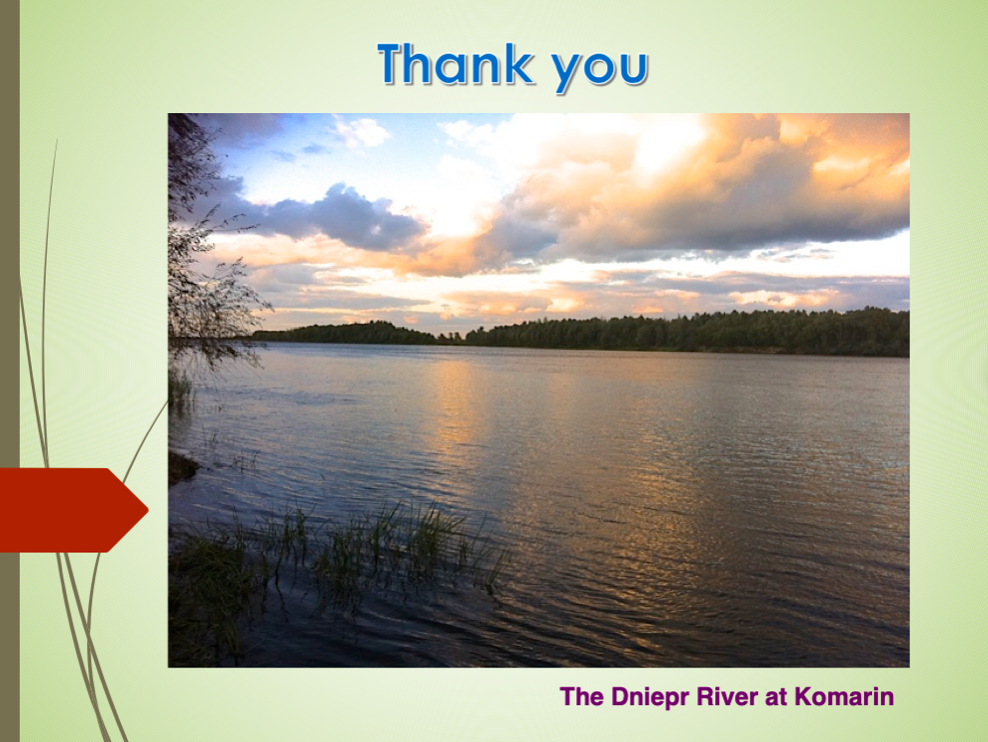
That’s about all. (In this picture,) you can see the place (I was talking about) and how beautiful it is. This is where I live, and there is the river. It’s the border between Belarus and Ukraine. You can catch purely clean fish in it. Only 14 Bq. Just several kilometres up of the stream, you can catch fish too, but a thousand Bq. I think this is it.
Message
Anastasia Fiadosenka
Dialogue Seminar in Fukushima City on July 7
Thank you for allowing me to be present at the Dialogue meeting. I have never dreamed of being able to come to Fukushima and Japan. I have listened to the dialogues and paid attention to everything you said. I see that what you have now is very similar to what we experienced. I feel like we are sisters and brothers.
(There was) one project for young mothers. We had a very similar project. I would like to encourage you, and say that our project’s children are grown-ups now and have their children and family.
At the same time, I see a very basic and fundamental difference because I see you as a country of opportunity. We were the first people to suffer from the consequences of a nuclear accident. You can draw a lot from our experience. You can get everything from our first-hand experience.
For example, the equipment we used, the whole-body counters were very old. We struggled to make a measurement. You have the opportunity to advance. I was asked “why did you not include in the presentation the diagram the results only from 2004 onward?” The answer to this question was very simple – this equipment, the whole-body counter, was simply non-existent.
After the CORE program was launched, we had the opportunity to use this kind of equipment. But Japanese people have the opportunity to use it now. There’s no delay.
Nowadays, we feel more or less privileged. We have this equipment. The government requires people to go through the whole body counting two times a year.
It has been for many years. Many things have changed, and the radiation doses are going down. But I still go to the medical center, collect data to find strange cases with elevated levels, go to the families, and try to find the source of contamination. And I work with every family continually.
I really sympathize with these village people, and I know what you’re going through because I was from a similar village. But there was also psychological pressure. They were labelled guinea pigs. But look at this skinny pig. I’m 70, and I’m still fine.
I would like to thank the CORE program, which allowed us to educate people and tell us how to apply simple radiological safety rules to dangerous situations in the contaminated area. There were people today speaking about educational programs connected with radiological safety. We try to make it in Belarus very practical. We bring measuring equipment, and we bring children to a study group. We demonstrate how we do the measurements, and we ask children to do it themselves and see how it works.
I have listened attentively to all of the reports and presentations, and I am amazed by the scientific method, public efforts of all the social organization, all the works that have been done. It’s wonderful. But I still think you need to move on to the individual level because you are still on the general level. Sometimes people are allied by fear. You can reach them and show them how they can do the measurement, and you can explain it to them.
We mentioned today several times that we accept the international norms for radiation exposure per year. I would like to point out it is composed of variable factors, variable types of internal, external exposure and the environmental radiation. But the most important is the intake of different types of food. Therefore, I think it’s very important for you to establish, if it hasn’t been done, the norms of radiation levels, or accumulation of isotopes in food.
I understand your fight with cesium-134 and -137. I understand your battle, and I understand your effort connected with decontamination. It is a difficult fight, and cesium will continue to show up. I have measured it for 20 years. Every year I make about 800 – 1000 cases of measurements, and I still find cesium in about 15% of products. I liked the presentation on the pumpkin making in Iitate Village – the effort and enthusiasm to produce clean products. I would like to take his seeds to Belarus, and I hope the custom allows that.
We know that the level of food contamination depends on the actual plants, not necessarily on the land. The land could be heavily contaminated. For instance, the corn plants that grew in a contaminated area were clean. In the plants of beans, peas, soy and some other products, the doses are accumulated 4, 5 time higher. Again, this is an example. I have done these measurements for so many years. I take simple things like dill. For example, some vegetables such as cucumbers or tomatoes are maximum of 12 Bq. But when I measure dill, it is 68-70 Bq.
The point I’m trying to make is not always the problem of decontamination. Sometimes it’s a problem of consumption (what we eat). We have learned different methods of lowering radiation level. It is obligatory to go to a radiological check if you eat food that has a high level of radiation accumulation.
When I looked at some of the people who make presentations, I see the enthusiasm and willingness to work. I have no doubt that you will succeed, and I wish you the best of luck.
